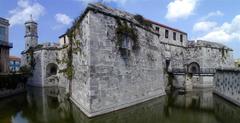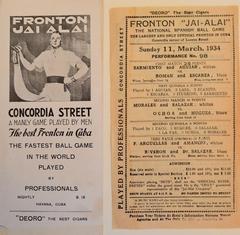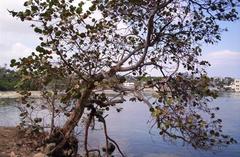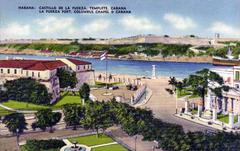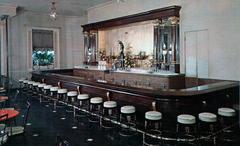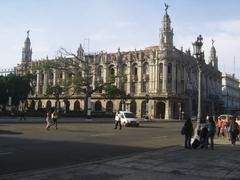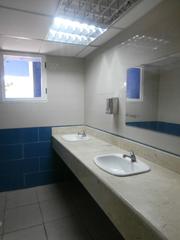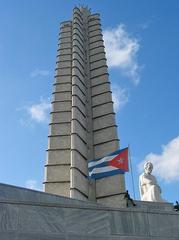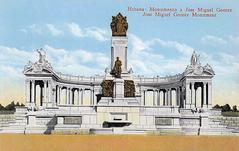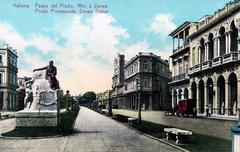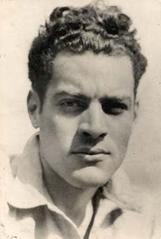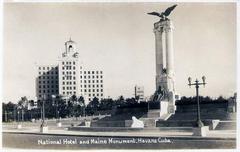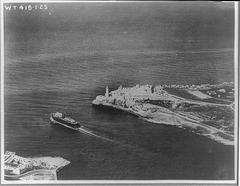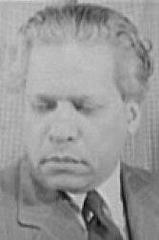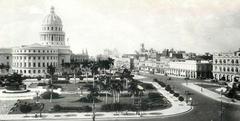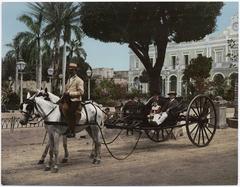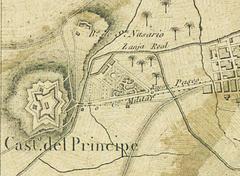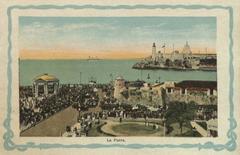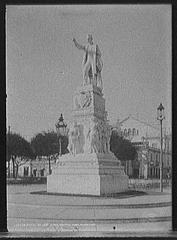Bacardi Building Visiting Hours, Tickets, and Havana Historical Sites Guide
Date: 04/07/2025
Introduction
The Bacardi Building (Edificio Bacardí) in Havana is a renowned Art Deco skyscraper and a symbol of Cuba’s architectural and cultural heritage. Completed in 1930, it was Havana’s first true skyscraper and stood as a testament to the city’s cosmopolitan ambitions during a period of economic prosperity. Designed by Esteban Rodríguez-Castells and Rafael Fernández Ruenes, with engineer José Menéndez Menéndez, the building is celebrated for its lavish use of imported granite, marble, and terracotta, and the iconic bronze bat sculpture perched atop its dome. Today, the Bacardi Building attracts visitors from around the world, offering historical significance, architectural splendor, and panoramic views of Old Havana. This guide provides comprehensive visitor information, including updated visiting hours, ticketing, accessibility, highlights, and practical tips, while also offering insight into the building’s enduring cultural impact (Accidentally Wes Anderson, Lonely Planet, Atlas Obscura).
Table of Contents
- Introduction
- Historical Background
- Architectural Highlights
- Visiting Information
- Cultural and Social Significance
- Nearby Attractions
- Practical Visitor Tips
- Frequently Asked Questions (FAQ)
- References
Historical Background
The Bacardi Building was commissioned by the Bacardi family, whose rum company had become a global symbol of Cuban entrepreneurship by the early 20th century. The headquarters was designed to reflect Bacardi’s prestige and Cuba’s embrace of modernity. Following the Cuban Revolution in 1959, Bacardi relocated abroad, but the building, with its enduring bat emblem, remains a powerful marker of Havana’s golden age and the city’s vibrant past (Cuban Travel Agency).
Architectural Highlights
Design and Materials
- Architecture: Art Deco, with stepped, ziggurat-inspired towers and geometric motifs (Wikipedia, Modern Magazine).
- Materials: Bavarian red granite, European marble, polychrome glazed terracotta tiles, and golden glazed accents (Trip Cuba, CubaPLUS Magazine).
- Iconic Features: The bronze bat sculpture atop the dome, a symbol of good fortune; decorative reliefs of nymphs and sirens; opulent marble lobby; and restored original elevators (Atlas Obscura, Melbourne Blogger).
Structural Innovations
Built on challenging ground in Old Havana, the building employs a foundation of hardwood piles and high-strength concrete, supporting its 12 stories and innovative steel-frame design for open interior spaces (Wikipedia).
Restoration
After years of post-revolutionary neglect, a major restoration was completed in 2003, preserving the building’s Art Deco features and ensuring its status as a protected heritage site (Pyomn).
Visiting Information
Location
- Address: Avenida de las Misiones, between Empedrado and San Juan de Dios, Old Havana (Lonely Planet).
- Getting There: Easily accessible by foot or taxi from central Havana and near major attractions like Parque Central and the Museum of the Revolution.
Visiting Hours and Tickets
- Hours: Open Tuesday to Sunday, 9:00 AM – 5:00 PM; closed Mondays and on public holidays. Note that hours may vary depending on local events or restoration work—always check ahead (Cuban Travel Agency).
- Admission: Entry to the lobby is free. Rooftop access (when available) typically costs around 1 CUC or 5–10 USD, with discounts for students and seniors. Guided tours may be booked through local agencies (GPSmyCity).
Accessibility
The building has elevators and some ramps, but due to its historic design, certain areas (especially the tower) may not be fully accessible for those with mobility challenges. Contact the building or tourism office in advance for specific accommodations.
Guided Tours and Special Events
Guided tours are available and recommended for those interested in the building’s rich history and architectural detail. Tours often include access to the rooftop for exceptional views of Old Havana.
Facilities
- Bar and Restaurant: Enjoy a cocktail in the Art Deco bar, echoing Bacardi’s legacy.
- Restrooms: Available to patrons.
- Languages: Spanish is the main language; some English may be spoken.
Cultural and Social Significance
The Bacardi Building is more than an architectural marvel; it is a cultural touchstone linking Cuban identity, modernity, and resilience. Its Art Deco style marked a break from colonial tradition and became a beacon of progress, luxury, and international ambition (Pineqone). The building also played a central social role, hosting Havana’s elite and cultural events, and today it continues to inspire pride, nostalgia, and creativity both in Cuba and the wider diaspora (Adequate Travel, Architectural Digest).
After the revolution, the building’s symbolism shifted, reflecting Cuba’s complex journey through innovation, upheaval, and adaptation. Restoration and community programming have further established the Bacardi Building as a site for cultural exchange and heritage education.
Nearby Attractions
Enhance your visit by exploring these nearby Havana historical sites:
- Old Havana (Habana Vieja): UNESCO World Heritage Site with colonial plazas, museums, and vibrant streets.
- Plaza de la Catedral: Home to Havana Cathedral and lively street performers.
- Malecón: The city’s iconic seaside promenade.
- Museo Nacional de Bellas Artes: Cuban and international art collections.
- Gran Teatro de la Habana: Stunning neobaroque theater.
- Parque Central & Capitolio Nacional: Major cultural and historical landmarks within walking distance (Lonely Planet).
Practical Visitor Tips
- Best Time to Visit: November–April (dry season) is ideal for comfortable exploration (Wanderlog).
- Dress Code: Light, breathable clothing and comfortable shoes are recommended.
- Photography: The façade, lobby, and rooftop offer excellent photo opportunities. Always check for restrictions before photographing interiors.
- Booking Tours: Reserve guided tours in advance for access to exclusive areas and in-depth insight.
- Accessibility: If you have mobility concerns, contact the building ahead of your visit.
- Combine Visits: Plan your day to include other nearby historical sites for a richer Havana experience.
Frequently Asked Questions (FAQ)
Q: What are the Bacardi Building’s opening hours?
A: Generally Tuesday to Sunday, 9:00 AM – 5:00 PM. Check locally for updates.
Q: How much does it cost to visit?
A: Lobby access is free. Rooftop or tower access typically costs 1 CUC or 5–10 USD.
Q: Is the building wheelchair accessible?
A: Elevators and ramps are present, but some historic areas (especially the tower) may be difficult to access.
Q: Are guided tours available?
A: Yes. Book in advance through official or local operators.
Q: Can I take photos inside?
A: Yes, but always ask staff about restrictions in certain areas.
Q: Is there a bar or restaurant on site?
A: Yes, the lobby features an Art Deco bar serving drinks and light fare.
References
- Accidentally Wes Anderson: Bacardi Building
- Lonely Planet: Edificio Bacardí
- Atlas Obscura: Bacardi Building
- Wikipedia: Bacardi Building (Havana)
- Modern Magazine: Building Bacardi
- Trip Cuba: Bacardi Building
- CubaPLUS Magazine: The Bacardi Building
- Melbourne Blogger: Bacardi Rum’s Building Resurrected
- Pyomn: Edificio Bacardi
- Pineqone: Bacardi Building
- Adequate Travel: Bacardi Building
- Architectural Digest: Building Bacardi
- Cuban Travel Agency: Bacardi Building
- Wanderlog: Edificio Bacardi
- GPSmyCity: Edificio Bacardi
- Official Havana Tourism Website
Plan Your Visit
The Bacardi Building is a highlight of Havana’s architectural landscape and a must-see destination for any visitor interested in Cuban history, design, and culture. To make the most of your experience:
- Verify opening hours and ticket requirements before your visit.
- Reserve guided tours for deeper insight and rooftop access.
- Combine your trip with nearby historical sites for a comprehensive Havana itinerary.
- Download the Audiala app for maps, personalized guides, and exclusive tips.
For further information on Havana’s historical sites, explore our related articles and follow us on social media for updates, travel inspiration, and cultural insights.

